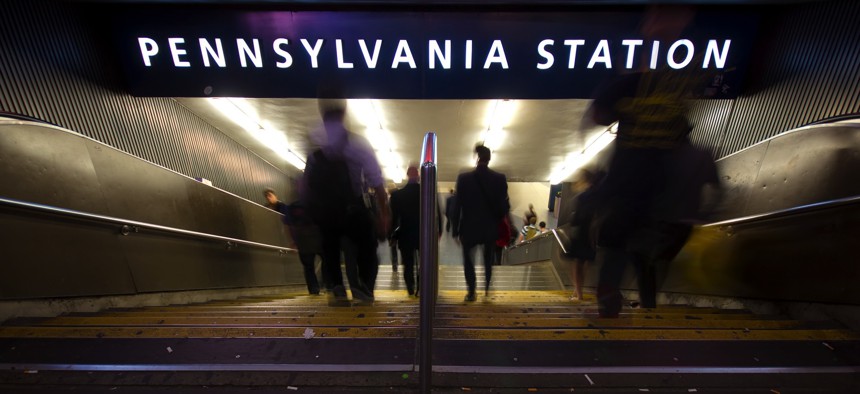Feds Increasingly Frustrated With Lack of State Action on Hudson River Tunnels

Pennsylvania Station in New York City littleny / Shutterstock.com

Connecting state and local government leaders
With the clock ticking down quickly, DOT Secretary Anthony Foxx says: “[W]e need to get down to brass tacks” on such a critical infrastructure project.
Amtrak’s 105-year-old twin tunnels under the Hudson River between New Jersey and New York City already had a quickly deteriorating shelf life even before corrosive salt water from Hurricane Sandy accelerated the timeline.
Those tunnels, originally built by the Pennsylvania Railroad, are not only critical to the economic health of the New York City region—bringing more than 160,000 commuters in and out of Manhattan on a daily basis—but the entire Northeast Corridor, the nation’s busiest rail line.
In order to revamp and repair the existing tunnels, one of the two will have to be shut down, which will cut train capacity in and out of New York's Pennsylvania Station from 24 trains per hour to six trains per hour. That would lead to an economic crisis for the nation’s largest city and, especially, for the state of New Jersey.
The need for a new tunnel is abundantly clear. But the sands in the hourglass are moving quickly.
Last year, Amtrak CEO Joseph Boardman said that the existing tunnels have less than 20 years left before they’ll need to be taken out of service.
And if meaningful action isn’t taken soon to figure out how to finance and build new tunnel capacity in and out of Manhattan, there won’t be enough time to construct a new tunnel infrastructure in time.
The federal government, frustrated by years of dilly-dallying by state officials in New York and New Jersey, has recently become more vocal in calling attention to the looming transportation crisis if nothing is done soon.
“The loss of a tunnel could have cataclysmic impacts on the entire regional economy,” Peter Rogoff, the undersecretary of transportation for policy, said in May during a meeting of regional leaders, according to Capital New York. Additionally, Rogoff, putting pressure on state leaders, said that Washington “may have foolishly thought that something as fundamental as [New York state’s Metropolitan Transportation Authority] capital plan would certainly have a solution by now.”
With major rail delays on the Northeast Corridor in and out of Manhattan this week, the tunnel conundrum has been in the news again. And U.S. Transportation Secretary Anthony Foxx has been out in front.
As The New York Times reported on Wednesday:
Mr. Foxx, the transportation secretary, said at a conference on Tuesday that the proposal to build new rail tunnels, known as the Gateway project, was “one of the — if not the — most important projects in the country right now that’s not happening.”
He said in an interview that he needed help from elected leaders in New York and New Jersey before it was too late. “I think that everybody at the state level is saying positive things, but we need to get down to brass tacks,” Mr. Foxx said, adding he had not yet seen significant momentum.
During his first term in office, New Jersey Gov. Chris Christie canceled a previous trans-Hudson tunnel project, known as Access to the Region’s Core or ARC, which he said would have put an undue burden on New Jersey taxpayers if there were cost overruns.
Since that action, which has been highly criticized, any major attention on the future transportation crisis involving the Hudson River tunnels has been from federal officials and Amtrak.
As noted transportation blogger Benjamin Kabak wrote at Second Avenue Sagas recently:
As we’ve seen, massive transit projects in the East Coast happen in half-decades (or longer) rather than in any sane timeline, and Gateway will be no exception. At a time of major political divides in Congress, Amtrak needs all the support it can get. It’s promising that the agency is going out on a limb to spend money today for something it may not be able to build tomorrow. At least they’re thinking about the future when few other agencies, both local and national, are. Can they deliver? It, of course, remains to be seen, but it’s not particularly hyperbolic to state that New York’s economic future may depend on it.
But it’s not just New York’s future, it’s also the entire Northeast Corridor, from Boston to Washington, D.C. and beyond. The big question is: Will federal, state and local officials act in time?
Michael Grass is Executive Editor of Government Executive’s Route Fifty.

NEXT STORY: Air Force, DLA move to Office 365





